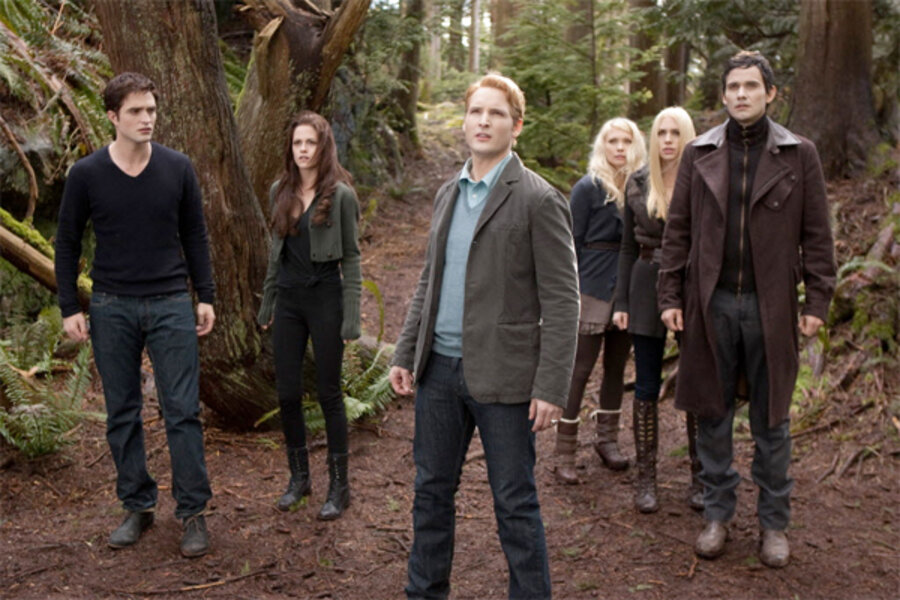'Breaking Dawn – Part 2': Why that twist ending is a good thing
Loading...
(Warning: Spoilers for part of “The Twilight Saga: Breaking Dawn – Part 2" ahead.)
After stars Kristen Stewart, Robert Pattinson, and Taylor Lautner took part in various interviews as part of a "Breaking Dawn" media blitz, the Internet started buzzing about hints the actors had dropped about a twist in the last movie of the “Twilight” series. A twist? There was no twist in the books. Would something be different? Would the ending be changed? Would protagonist Bella Swan (Stewart) end up with someone besides her vampire husband Edward (Pattinson)? What did it mean?
And now the movie, “The Twilight Saga: Breaking Dawn – Part 2” (ask film critics how happy they are not to have to type that out anymore) has been released, and it was discovered that, while there was a twist, it didn’t affect the outcome of the story as a whole, though it did get the audience on the edge of their seats.
You see, to make a very long story short, the end of “Dawn” has Bella, Edward, and their vampire family facing off against evil vampires. At one point, it looks like a fight begins and Edward’s foster father, one of his foster brothers, and the leader of the evil vampires, among others, bite the dust (no pun intended) in the attack. Then it turns out that this was all a vision, a hypothetical situation, if you will. One of the good vampires, who can see the future, has shown the vision to the leader of the evil vampires to show him what the cost of the two sides fighting would be. This helps convince the head evil vampire (Michael Sheen, who by all accounts goes gloriously crazy as bad vampire Aro in this movie) to call off the battle.
Of course, while this scene was not actually a change to the plotline (it’s referenced in the books that Aro is made to see the vision, though the reader only hears about it afterwards), some fans still didn’t like it.
My take? Good for them for changing SOMETHING (even if, comparing it to the text, it’s an incredibly small change).
I know that adapting a book into a film is an incredibly delicate balance, even more so when the book has a devoted fanbase attached. But the director and the creative team behind him or her needs to feel free to create the best product, the best movie, that they can without it being obvious that they tied themselves to every word on the page of that book.
Case in point: the “Harry Potter” films, an almost parallel case in terms of how attached fans are to the books (and a franchise I happen to like a lot more than “Twilight” – sorry, fans). The first two movies in the eight-part series were directed by “Home Alone” helmer Chris Columbus and are fine, but you could almost feel the desperation in “Sorcerer’s Stone” and “Chamber of Secrets” to pack everything in, make sure no moment was missed, get as close an adaptation as possible.
“Director Chris Columbus vowed to be faithful to J.K. Rowling's Harry Potter and the Sorcerer's Stone, and to a certain extent he is,” USA Today critic Claudia Puig wrote of the first movie. “But one can be faithful to a plot without being faithful to the book. Harry Potter, the film, looks just as dazzling as readers of Rowling's captivating book might hope. But the movie ultimately lacks the book's delightful whimsy and much of the sly verbal humor that made Rowling's tales so charming.”
But then Columbus left after “Secrets,” and the next movie in the series, “Harry Potter and the Prisoner of Azkaban,” was directed by Alfonso Cuaron. His adaptation just seemed easier, more relaxed – a trend that would continue with the rest of the movies, which were directed by two others (Mike Newell and David Yates) but had a similarly effortless air. Yes, things were left out, and sometimes – gasp – things were even different, such as the way the members of the secret club known as Dumbledore's Army were rounded up by evil headmistress Umbridge in the fifth movie. In the movie, the headmistress and her henchmen make a wall explode, revealing the members inside a hidden room. Did that happen in the book? Nope. Did that look awesome in the movie? Definitely.
Many liberties were also taken with the plot of the eighth movie, which was the second half of the seventh book, but you barely heard a peep about them from fans. Supporting character Lavender Brown, who was attacked by a werewolf but survived in the novel, was killed by the werewolf in the movie, but that showed the cost of the evil attack on the school, one which killed a lot of students. We saw, and didn’t just hear about secondhand, a scene in which two of the main characters, Ron and Hermione, finally got together, and fans literally cheered, because everyone had wanted to see that anyway.
As every book fan who is also a moviegoer knows, literary adaptations have a bad track record. And sure, directors who are given the task of creating an adaptation shouldn’t toss the book away and start throwing whatever they feel like in front of the camera. But a movie is its own entity, not just an extension of the book – or at least, it should be.
So breathe, Twihards. It’s going to be okay.






